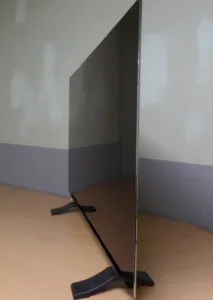While LG is leading the charge to bring OLEDs to the consumer TV market, firms like Primeview are working hard to bring the technology to commercial and professional applications ranging from military and aerospace, to broadcast and control rooms, to high-end retailers. At ISE 2015, the company launched the new 55” OLED panel with HDBaseT connectivity. To learn more, we spoke with Chanan Averbuch, Vice President of Marketing and Sales at Primeview.
Averbuch explained that the firm has been working with LG’s Semiconductor division to develop these commercial OLED products. The Semiconductor group is happy to supply the small volumes needed for commercial customers because sourcing from LG Display requires minimum orders in the 20K unit range – something that is not possible in the nascent OLED commercial market. Primeview in turn, develops the electronics to support commercial applications.
The 55” OLED panel released at ISE will be offered with HDBasetT connectivity (PRV55OLEDHDBT) or without, depending upon customer needs. “We think the HDBaseT connectivity is a really great option for our consultants, value added resellers and ultimately the end user as it simplifies the installation and driving of the display”, noted Averbuck.
This first OLED panel is an FHD resolution model that offers very fast 0.1 ms response time, wide viewing angles, 400 nits of brightness, 10-bit color, 120 Hz refresh rate, and the deep blacks and high contrast you expect from OLED. In addition, a new 55″ video wall version is coming in Q3’15 that will have bezel widths that are under 2mm (current models are under 10mm). That’s really thin, but not invisible.
Averbuch also said that the current FHD resolution panels will start to migrate to UHD resolution this year (expect new 55″ and 65″ UHD-4K models in Q2’15). This will come first to standalone products and to video wall products in 2016. “As the inventories of FHD commercial panels decline, you will see suppliers substituting UHD-4K panels instead. These offer better margins”, explained Averbuck.
He also noted that Primeview will offer OEM versions of these panels to some of their customers like Honeywell, GE, Lockheed Martin and others.
When we asked what the price premium will be for these OLED panels, Averbuck said they like to compare the 55” FHD OLED to a 4K-UHD LCD panel. Doing so results in a price premium of 100% or twice the price of the LCD (even though the OLED is still FHD resolution). They do this because they see the market migrating to UHD-4K resolution panels fairly quickly so they advise on buying 4K when you can to future proof your install. This price premium will decline quickly, he thinks.
So where is OLED and 4K preferred? Averbuck says any application where people are close to the display will benefit from the increased resolution a 4K-UHD panel will offer – no surprise there. That includes wayfinding kiosks, digital signage, desktop control room applications, security, broadcast OB vans and control rooms and more.
“One of the big advantages of UHD-4K in these markets is the multi-viewer application,” says Averbuch. “In broadcast, control rooms, security and some industrial process applications, there are multiple video feeds that need to be monitored and being able to window four FHD feeds at full resolution on one display is a big advantage because of the increased clarity of each feed.”
“For OLEDs, we are finding the wide viewing angle and no loss of color quality and contrast at these angles is a major selling point,” continued Averbuch. For example, Boeing is installing OLEDs on ship bridges because many people need to see these displays and they are just a lot better than LCDs for this.”
He also noted that high end retails like the image quality possible with OLEDs to create an experience commensurate with brands like Channel or Christian Dior.
Somewhat surprisingly, Averbuck also noted that they are finding the OLEDs are more rugged than LCDs. “We have been doing testing on OLEDs to Mil-Spec standards and finding they are easier to qualify than LCDs, and even though they are thinner, they are not fragile as one might think.”
Analyst Comment
As we said in our ISE round-up, we saw the Primeview display on the HDBaseT booth at ISE. After several days of looking at very bright LCDs and LEDs, the low level of brightness was apparent. This would not be a problem in a control room or OB van application, but it will be a barrier that OLED will face. (BR)

